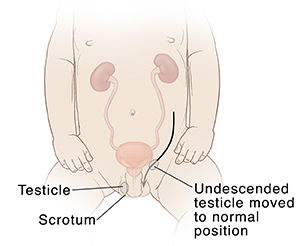Surgery for an Undescended Testicle
Surgery for an Undescended Testicle

Why treatment is needed
The longer a testicle remains outside the scrotum, the more likely it is that it will produce fewer sperm.
An undescended testicle has a higher risk of cancer. This is true even after the testicle is brought down into the scrotum. But, bringing the testicle down makes a problem easier to find.
An undescended testicle can leave a small tear (hernia) in the wall between the abdomen and the groin. The hernia needs to be treated to prevent future problems.
Surgery
The testicle is brought down into the scrotum during surgery.
You and your son are asked to arrive at the hospital or surgery center 1 to 2 hours before surgery.
Anesthesia is given to keep your son comfortable.
An opening (incision) is made in the groin or abdomen. Another small incision is made in the scrotum.
The testicle is detached from the tissue around it. Then it is brought down and stitched to the wall of the scrotum.
After surgery
Your son will most likely go home a few hours after surgery. He should be feeling better in 2 to 3 days.
The doctor may prescribe medicine to relieve any pain your child has. Be sure to use it as directed.
Your child should only have sponge baths for the first 1 to 2 days and then resume normal bathing activities or as directed by your child's surgeon.
Most children will have one incision in the groin and a second incision in the scrotum. No topical care for the incisions are required as they are closed with skin glue which will gradually flake off, Stitches will dissolve as your child resumes his normal bathing activities. Or, your child may have stitches that will need to be removed 7 to 10 days after surgery.
It is normal for the scrotum to appear swollen and bruised around the scrotal incision. This will all resolve with time and usually appear much better in a week.
Your child should avoid swimming in a pool or lake water for 2 weeks after surgery.
Light activity is fine, but your child should not participate in strenuous activities like sports for 3 to 4 weeks after surgery or as directed by your child's surgeon.
When to call your child's healthcare provider
Call your healthcare provider if your otherwise healthy child has any of the signs or symptoms described below:
The incision bleeds or becomes red, or there is a discharge from the incision
The child cries all the time
Fever (see Fever and children, below)
Seizure due to fever
Fever and children
Always use a digital thermometer to check your child’s temperature. Never use a mercury thermometer.
For infants and toddlers, be sure to use a rectal thermometer correctly. A rectal thermometer may accidentally poke a hole in (perforate) the rectum. It may also pass on germs from the stool. Always follow the product maker’s directions for proper use. If you don’t feel comfortable taking a rectal temperature, use another method. When you talk to your child’s healthcare provider, tell him or her which method you used to take your child’s temperature.
Here are guidelines for fever temperature. Ear temperatures aren’t accurate before 6 months of age. Don’t take an oral temperature until your child is at least 4 years old.
Infant under 3 months old:
Ask your child’s healthcare provider how you should take the temperature.
Rectal or forehead (temporal artery) temperature of 100.4°F (38°C) or higher, or as directed by the provider
Armpit temperature of 99°F (37.2°C) or higher, or as directed by the provider
Child age 3 to 36 months:
Rectal, forehead (temporal artery), or ear temperature of 102°F (38.9°C) or higher, or as directed by the provider
Armpit temperature of 101°F (38.3°C) or higher, or as directed by the provider
Child of any age:
Repeated temperature of 104°F (40°C) or higher, or as directed by the provider
Fever that lasts more than 24 hours in a child under 2 years old. Or a fever that lasts for 3 days in a child 2 years or older.
Updated:
August 07, 2018
Sources:
North, A. Textbook of Pediatric Care (2009); Part 9; pp. 279
Reviewed By:
Greenstein, Marc, DO,Image reviewed by StayWell medical illustration team.,Turley, Ray, BSN, MSN